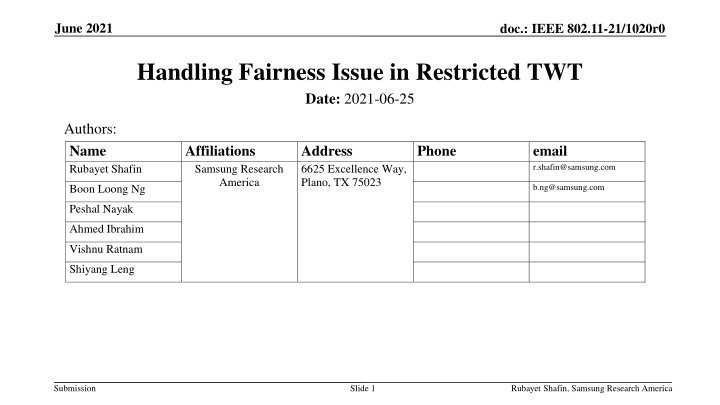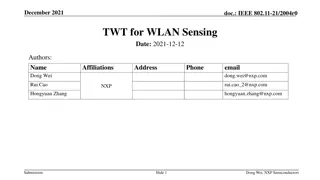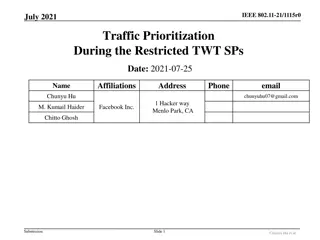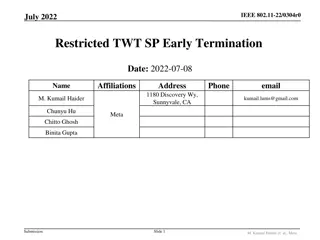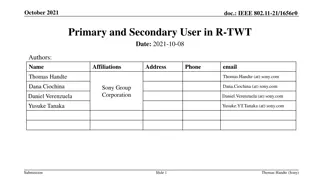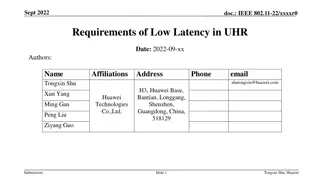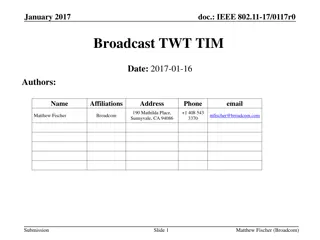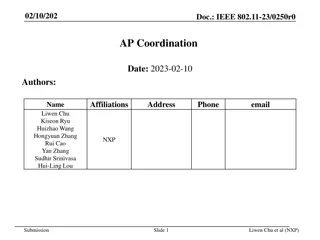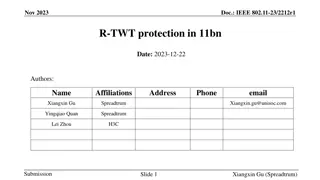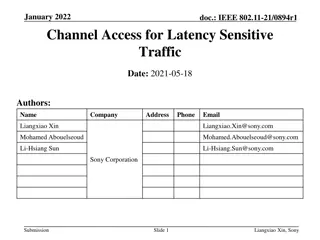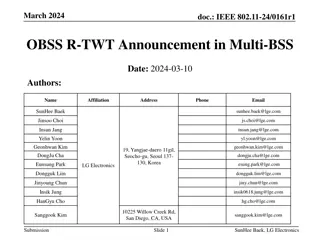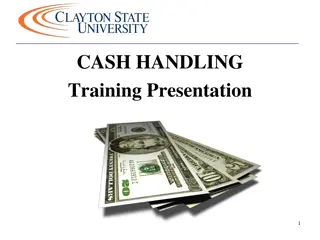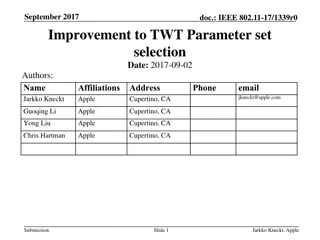Handling Fairness Issue in Restricted TWT Operation
Proposal addressing fairness vs. channel utilization tradeoff in restricted Target Wake Time (TWT) operation for IEEE 802.11 networks. Solution suggested for underutilization of TWT schedules due to early completion of latency-sensitive transmissions, mitigating fairness concerns while optimizing channel utilization.
Download Presentation

Please find below an Image/Link to download the presentation.
The content on the website is provided AS IS for your information and personal use only. It may not be sold, licensed, or shared on other websites without obtaining consent from the author.If you encounter any issues during the download, it is possible that the publisher has removed the file from their server.
You are allowed to download the files provided on this website for personal or commercial use, subject to the condition that they are used lawfully. All files are the property of their respective owners.
The content on the website is provided AS IS for your information and personal use only. It may not be sold, licensed, or shared on other websites without obtaining consent from the author.
E N D
Presentation Transcript
June 2021 doc.: IEEE 802.11-21/1020r0 Handling Fairness Issue in Restricted TWT Date: 2021-06-25 Authors: Name Rubayet Shafin Affiliations Samsung Research America Address 6625 Excellence Way, Plano, TX 75023 Phone email r.shafin@samsung.com b.ng@samsung.com Boon Loong Ng Peshal Nayak Ahmed Ibrahim Vishnu Ratnam Shiyang Leng Submission Slide 1 Rubayet Shafin, Samsung Research America
June 2021 doc.: IEEE 802.11-21/1020r0 Abstract In this contribution, we propose a solution for the issue regarding Restricted TWT SP where STA is done with transmitting (and receiving) latency- sensitive packets earlier than TWT SP end time. Submission Slide 2 Rubayet Shafin, Samsung Research America
June 2021 doc.: IEEE 802.11-21/1020r0 Background Restricted TWT operation is a newly proposed strategy based on broadcast TWT operation [1], [2] - Provides more protection for latency-sensitive traffic - Minimize contention between STAs In this contribution, we address the fairness vs channel utilization tradeoff for restricted TWT operation. Submission Slide 3 Rubayet Shafin, Samsung Research America
June 2021 doc.: IEEE 802.11-21/1020r0 Motivation During restricted TWT SP, it is possible that a scheduled STA, member of the restricted TWT schedule, finishes transmitting latency-sensitive traffic earlier than the restricted TWT SP end time. This leaves underutilized restricted TWT SP for that STA (if DL buffer for latency-sensitive traffic is also empty for that STA). Submission Slide 4 Rubayet Shafin, Samsung Research America
June 2021 doc.: IEEE 802.11-21/1020r0 Fairness vs Channel utilization trade-off Channel under-utilization due to under-utilized restricted TWT SP can be reduced by allowing latency-tolerant traffic in addition to latency-sensitive traffic for transmission during rTWT SP. Once the scheduled STA is done transmitting latency-sensitive traffic during rTWT SP, and if there is still time remaining in the SP, the scheduled STA can choose to transmit its latency-tolerant packets (if any) during remaining of the SP. This will improve the channel utilization for the STA However, it creates fairness issue Regarding contention among the scheduled STAs, if one scheduled STA starts transmitting latency-tolerant traffic during the restricted TWT SP, it is not fair for other scheduled STAs that are still transmitting latency- sensitive traffic during the SP. Also, an STA with ill intention may abuse this functionality by setting up TWT parameters such that there is always additional time left in the restricted TWT SP after transmitting latency-sensitive packets. Submission Slide 5 Rubayet Shafin, Samsung Research America
June 2021 doc.: IEEE 802.11-21/1020r0 A Fair Outcome If STA2 is done transmitting latency-sensitive traffic early, and if downlink buffer for latency-sensitive traffic is also empty for STA2, a fair outcome would be to terminate rTWT SP for STA2 so that it can transmit latency-tolerant traffic (if any) competing with other STAs that are not members of the rTWT SP. This is also fair for other member STAs since they still maintain priority for latency-sensitive traffic during remaining period of SP. Submission Slide 6 Rubayet Shafin, Samsung Research America
June 2021 doc.: IEEE 802.11-21/1020r0 Rules for Handling Fairness Issue (1) Once an STA is done transmitting latency-sensitive traffic, and there is still time left in the restricted TWT SP, then the STA can report its buffer status to the scheduling AP. The buffer status shall contain the queue sizes of all TIDs corresponding to its latency-sensitive traffic. The queue size = 0 for latency-sensitive TIDs shall accordingly indicate the AP that the STA s buffer for latency-sensitive traffic is empty. If the AP receives BSR from a scheduled STA indicating empty buffer for latency-sensitive traffic, the scheduling AP can terminate the restricted TWT SP for that particular scheduled STA if the AP didn t receive such empty buffer indication from any other scheduled STA, and if downlink buffer for latency sensitive traffic for that STA is also empty. AP can transmit an individually addressed QoS Data or QoS Null frame with EOSP subfield equal to 1 AP can send an individually addressed frame with More Data field set to 0 If the AP receives BSR from all scheduled STAs indicating empty buffer for latency-sensitive traffic, and if downlink buffers corresponding to latency sensitive traffic for all STAs are also empty, then the scheduling AP can terminate the restricted TWT SP for all scheduled STAs AP can transmit a broadcast QoS Data or QoS Null frame with EOSP subfield equal to 1 Submission Slide 7 Rubayet Shafin, Samsung Research America
June 2021 doc.: IEEE 802.11-21/1020r0 Rules for Handling Fairness Issue (2) During restricted TWT service period, if the scheduling AP detects that a scheduled STA is transmitting latency-tolerant traffic, then the scheduling AP can terminate the restricted TWT SP for that scheduled STA AP can transmit an individually addressed QoS Data or QoS Null frame with EOSP subfield equal to 1 AP can send an individually addressed frame with More Data field set to 0 During restricted TWT service period, if the scheduling AP detects that all scheduled STAs are transmitting latency-tolerant traffic, then the scheduling AP can terminate the restricted TWT SP for all scheduled STAs AP can transmit a broadcast QoS Data or QoS Null frame with EOSP subfield equal to 1 Submission Slide 8 Rubayet Shafin, Samsung Research America
June 2021 doc.: IEEE 802.11-21/1020r0 Example (1) STA2 is done with transmission earlier than rTWT SP end time Submission Slide 9 Rubayet Shafin, Samsung Research America
June 2021 doc.: IEEE 802.11-21/1020r0 Example (2) AP lets STA2 know that its downlink buffer is empty. Reception of MD-STA2 would indicate that STA2 s rTWT SP is terminated. Submission Slide 10 Rubayet Shafin, Samsung Research America
June 2021 doc.: IEEE 802.11-21/1020r0 References [1] IEEE P802.11ax/D8.0 26.8.3 (Broadcast TWT operation) [2] IEEE P802.11ax/D8.0 10.47 (Target Wake Time) [3] IEEE P802.11be/D0.4 35.7 (Restricted TWT) Submission Slide 11 Rubayet Shafin, Samsung Research America
June 2021 doc.: IEEE 802.11-21/1020r0 Fairness vs Channel utilization trade-off Channel under-utilization due to under-utilized restricted TWT SP can be reduced by allowing latency-tolerant traffic in addition to latency-sensitive traffic for transmission during rTWT SP. Once the scheduled STA is done transmitting latency-sensitive traffic during rTWT SP, and if there is still time remaining in the SP, the scheduled STA can choose to transmit its latency-tolerant packets (if any) during remaining of the SP. This will improve the channel utilization for the STA However, it creates fairness issue Regarding contention among the scheduled STAs, if one scheduled STA starts transmitting latency-tolerant traffic during the restricted TWT SP, it is not fair for other scheduled STAs that are still transmitting latency- sensitive traffic during the SP. Also, an STA with ill intention may abuse this functionality by setting up TWT parameters such that there is always additional time left in the restricted TWT SP after transmitting latency-sensitive packets. Submission Slide 12 Rubayet Shafin, Samsung Research America
June 2021 doc.: IEEE 802.11-21/1020r0 SP 1 Do you agree that in R1: - EHT APs and EHT STAs that support restricted TWT (rTWT) operation and that have established an rTWT schedule shall follow the rules below-- Once an rTWT scheduled STA is done with transmitting latency-sensitive traffic, and there is still time left in the rTWT SP, then the rTWT scheduled STA shall report its buffer status to the rTWT scheduling AP. If the rTWT scheduling AP receives Buffer Status Report (BSR) from an rTWT scheduled STA indicating empty buffer for latency-sensitive traffic, the scheduling AP can terminate the rTWT SP for that particular scheduled STA if downlink buffer for latency sensitive traffic for that STA is also empty. Submission Slide 13 Rubayet Shafin, Samsung Research America
June 2021 doc.: IEEE 802.11-21/1020r0 SP 2 Do you agree that in R1: - EHT AP that supports restricted TWT (rTWT) operation and that has established an rTWT schedule shall follow the rule below-- During rTWT service period, if the rTWT scheduling AP detects that an rTWT scheduled STA is transmitting latency-tolerant traffic, then the rTWT scheduling AP can terminate the rTWT SP for that scheduled STA. Submission Slide 14 Rubayet Shafin, Samsung Research America
